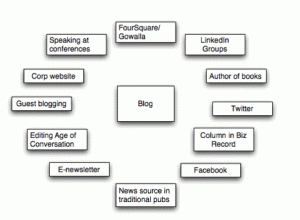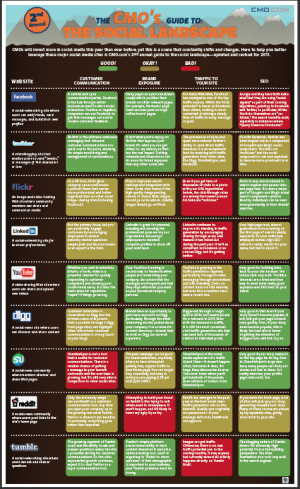Today I have a guest post from Drew Neisser that appeared in Mediapost.
Experience is a great teacher but why not learn from the mistakes of others and save yourself the trouble? Attending lots of conferences, I'm occasionally struck by all the lessons -- good and bad -- that are readily available. At one such conference recently a marketing exec presented a case so flawed it was truly inspiring, pushing me to chronicle the 5 most common social media mistakes in glorious detail.
#1 Thinking of social as just another media channel
They say that to a hammer, everything looks like a nail. To a marketer, every new opportunity looks like yet another place to hammer home their message. Donnie Deutsch, the former mad man, just last year at the 140 Characters Conference compared the arrival of social with the arrival of cable TV in the 1980s, calling it "just another media channel." Having sold his agency to Interpublic in 2000 for $275 million and enriched himself further as a talk show host, Donnie can be forgiven this seemingly innocuous oversight. But daily marketing practitioners can't afford to do so.
Media channels like TV, cable or otherwise, deliver a monologue, in which advertisers shout with the hope of being heard; promise with the hope of getting a sale. Social media is a conversation in which the brand must first listen and then offer something of value in order to gain an invitation to interact. Social media is not about selling, it's about providing a service that engages, enlightens or entertains. It's about listening really carefully and responding with equal regard.
American Express listened for six months before they set up their first Twitter account. Through a careful listening campaign, Avaya was able to beat its competitors to the punch, identifying leads and new product opportunities. Virgin Media's London-based "tweam" turned a complaining Stephen Fry into a staunch advocate, helping the cable company to engage with Fry's more than 1.5 million followers. All three of these examples stress the importance of listening -- something that traditional media efforts did not require or allow.
#2 Leaving social media to the "twinterns"
Because social media is still in its infancy and second nature to Millennials, the tendency has been to put the social media reins in the hands of a person fresh out of school or the intern with the most friends on Facebook. One senior marketing exec told the author of Facebook for Dummies Paul Dunay that she was absolutely thrilled to have hired a "twintern" to take care of her brand's Twitter account. A startled Dunay reflected later on his blog: "When did it become okay to just give anyone off the street the keys to one of the most important assets you have ... your brand!"
The risks of this approach have become readily apparent. Nestle, a brand that has come under repeated attack by activist groups like Greenpeace, only made matters worse when junior staffers responded flippantly to negative posts on its Facebook Wall. More recently, a junior staffer at a Detroit-based social media agency lost his job and the Chrysler account for his agency, when his snide response about Detroit drivers went out on the Chrysler Twitter feed. There are many such stories and all smack of immaturity and inexperience.
Now don't get me wrong -- I have nothing against interns, and in fact, they can play an invaluable and cost-effective role monitoring, reporting and even ideating responses. That said, we would never rely on one to manage our own social media interactions any more than we would let them lead engagements with our clients. If you start to think of social media like your customer service activities, then you, too, will seek pros to lead the way.
#3 Ready, fire, aim
Perhaps because it's so easy to set up a Facebook page, start a Twitter account and throw up a video on YouTube, many brands did just that, without much foresight. Many of these pages languish sadly like falling trees with no one there to listen. When a customer or prospect sees these pages, the message is, unfortunately, clear: Here is a company that doesn't have its act together. Such ill-planned approaches are a potent reminder that "hope is not a strategy."
Like boxing, social media looks pretty simple to the untrained eye, but who among you would dare jump into the ring without a lot of preparation and, better yet, a real plan of attack? In social media, preparation is essential to avoiding an accidental knockout. Brands must commit significant resources, and equally important, have a process in place for managing customer interactions, establishing an escalation policy when complaints arise.
In the past few months, several brands including Dell and Gatorade have made headlines by establishing a "command center" for their social media activities. Listening and responding with equal care, these brands have also established social media policies for employees and their customers, defining what each should expect from the other. These centers are staffed 24/7 and reflect a growing appreciation for the need to treat social media as a strategically guided weapon.
#4 Don't define success
Consistent with the ready, fire, aim mentality often brought to social media, it is not surprising that success is rarely defined at the beginning. With only 23% of companies having a strategic plan in place for social in 2010 (MarketingSherpa), many more were just jumping into the water, not knowing which way to swim or how far to go.
Ironically, defining success in social media isn't all that hard, especially when put into the context of the overall business goals. Boiling this down to basics, every business needs to do two things to survive, acquire customers and retain them. And typically, the better you are at retaining customers, the easier it is to acquire new ones. Well, sure enough, social media can do both of these things in highly measurable ways. (These are not the only uses for social, but these are the ones the c-suite cares about the most.)
Kinaxis, a Canada-based supply chain management company, has used a combination of blogging and community building to nearly triple Web traffic and lead generation. U by Kotex has developed a highly engaged fan base on Facebook that, in combination with provocative advertising that went viral on YouTube, has helped it grow from 0% to 20% share of market.
#5 Isolate in one department
Because social media often starts as a subset of one department or another, there has been a bit of a battle for control at numerous companies. Many departments can make a compelling case for ownership -- Marketing because it understands the voice of the brand, Customer Service because it is trained to interact with customers and Corporate Communications because blogger and influencer outreach feels a lot like PR.
These battles are unfortunate and have often left social isolated and restrained by the perspective of just one department. However, as Bonin Bough of PepsiCo explained at a recent conference, "It's not about ownership, it's about leadership." To be successful, social media initiatives need to be led by an individual or team of individuals that can rise above a particular department and then tap into all the requisite disciplines, including IT.
Twelpforce, the groundbreaking Twitter-based help desk from Best Buy, provides a great example of how these cross-disciplined programs can come into being. Originated in the marketing department, the Twelpforce application was coded by an internal IT team. The Twelpforce itself is made up of 2,600 Best Buy employees from all over the company, including customer service. In its first year, the Twelpforce responded to over 42,000 customer inquiries at a remarkably low cost-per-interaction and remarkably high c-sat rate.
Drew Neisser is CEO and founder of New York-based Renegade, the digital and guerrilla agency whose "marketing as service" philosophy helps clients make more out of less year after year. A long-time believer in the transformative power of brand experiences, you can find Drew's musings on TheDrewBlog.com and twitter.com/DrewNeisser. Reach him here.
Part 2? Wednesday at noon.
 Too Much Information.
Too Much Information.
























